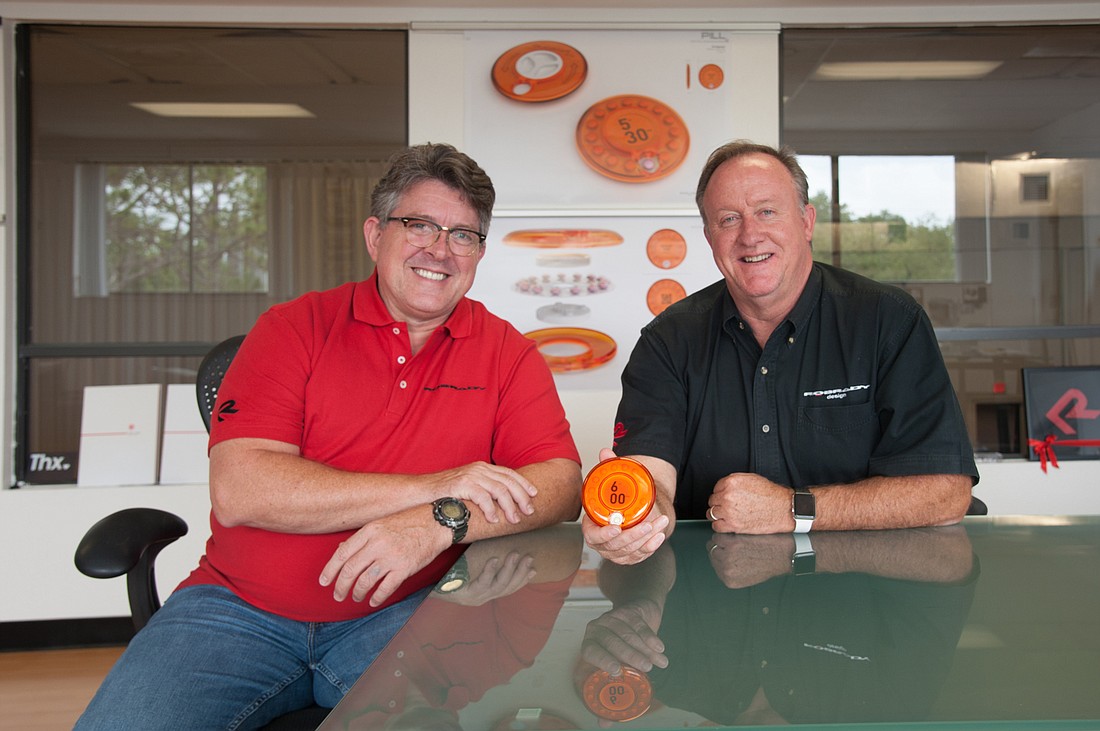There’s a high cost to the opioid crisis. A White House report from The Council of Economic Advisers in November 2017 estimates that over 33,000 Americans died of a drug overdose involving opioids in 2015. It also estimates that the economic cost of the crisis was $504 billion in 2015.
That's the crisis Sarasota-based product design firm Robrady recently entered, by working to develop a solution for a key point in the problem: when pills are dispensed to the patient.
Robrady's solution is PILL, an acronym that stands for Prescribed Interval Limit Lock.
Here's how PILL works: a doctor creates an order for a specific medicine, dosage and regime. The manufacturer would follow the order and set the timer inside the PILL device prior to the patient receiving it. Then the device would serve pills at the prescribed interval.
“Controlling the time between any two pills — I thought it was a stroke of genius.” — Robert Brady, CEO and design director, Robrady
Robert Brady, CEO and design director of Robrady says, “Controlling the time between any two pills — I thought it was a stroke of genius.”
So much so that a team of Robrady employees traveled to Washington, D.C., in mid-April to meet with officials from a variety of government agencies to drum up support for PILL and spread awareness of the product. During the trip, the Robrady team met with representatives from the Department of Health and Human Services and the Food and Drug Administration as well as representatives of U.S. Sen. Marco Rubio, R-Miami, and U.S. Sen. Lamar Alexander, R-Tenn.
PILL came to Robrady from medical professional Afton Heitzenrater, her husband, Jeff Heitzenrater, and Joe Bujalski, Jeff Heitzenrater’s uncle.
Afton Heitzenrater has been a practicing physician assistant for eight years. She previously worked in an orthopedic office, where she says she saw the effects of the opioid crisis firsthand. More connection the crisis: One her cousins died of an overdose.
Today Heitzenrater works in the emergency department at Rochester General Hospital. “Now every shift I work, I see an overdose patient,” she says. “We want to treat your pain, but we want to do it in a responsible fashion.”
With all she’s seen, she also wanted to be part of a solution. So she got to work with her husband and Bujalski to develop a product. Bujalski assisted with funding, business knowledge and patents.
Two years ago, Bujalski approached Robrady to create a prototype. Since then it’s been a collaboration between him, Afton Heitzenrater, Jeff Heitzenrater and Robrady.
Colin Leonard, director of manufacturing operations for Robrady, says the initial product brought to them was similar to the mechanical workings inside a vintage music box with metal gears and springs.
When the Robrady team started to brainstorm, they thought about the design of birth control pill packs and prescription blister packs. “We do a lot of design work related to the human experience,” Brady says. The design of PILL is a simple and innovative solution, he says.
The resulting device, now with several additional patents pending in the U.S. and internationally, includes what Leonard calls a tiny computer that sends an electronic signal to unlock the locking mechanism. That allows the patient to rotate the internal blister pack and release the next medication dose.
The device isn’t tamper-proof but tamper-evident. It’s expected to cost about $2 per prescription — which Brady says cost could be lowered if the device is produced at greater quantities.
The next phase in the life of PILL is additional engineering to prepare for the manufacturing of hundreds of mockups for testing. It will be six to nine months before Robrady starts testing functional products. Then, Brady says, the company aims to work with regulatory bodies.
To get PILL to the finish line, Robrady also seeks outside funding. So far, hundreds of thousands of dollars have been invested in the project, according to Brady. The next phase of development is targeted at $1 million.
There’s a potential broader application for PILL, including use for other medications and as a way to alert patients when it’s time to take another dose.
But for now, the road ahead points straight at tackling the opioid crisis. Leonard says, “We wanted, for obvious reasons, to focus on the life-and-death crisis in front of us.”






